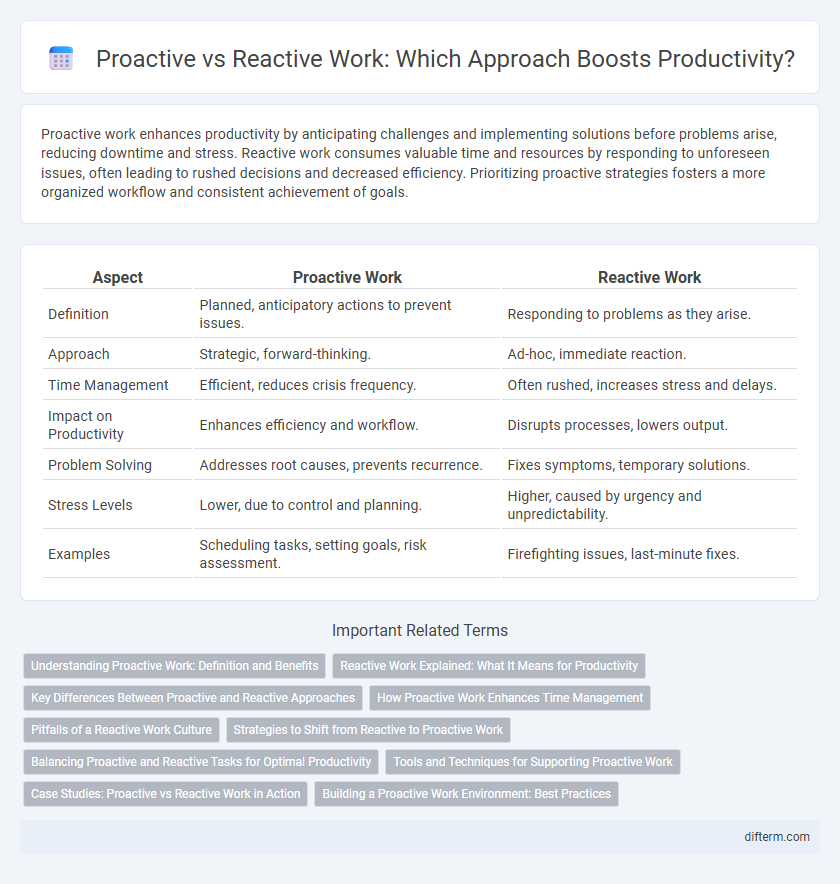Proactive work enhances productivity by anticipating challenges and implementing solutions before problems arise, reducing downtime and stress. Reactive work consumes valuable time and resources by responding to unforeseen issues, often leading to rushed decisions and decreased efficiency. Prioritizing proactive strategies fosters a more organized workflow and consistent achievement of goals.
Table of Comparison
| Aspect | Proactive Work | Reactive Work |
|---|---|---|
| Definition | Planned, anticipatory actions to prevent issues. | Responding to problems as they arise. |
| Approach | Strategic, forward-thinking. | Ad-hoc, immediate reaction. |
| Time Management | Efficient, reduces crisis frequency. | Often rushed, increases stress and delays. |
| Impact on Productivity | Enhances efficiency and workflow. | Disrupts processes, lowers output. |
| Problem Solving | Addresses root causes, prevents recurrence. | Fixes symptoms, temporary solutions. |
| Stress Levels | Lower, due to control and planning. | Higher, caused by urgency and unpredictability. |
| Examples | Scheduling tasks, setting goals, risk assessment. | Firefighting issues, last-minute fixes. |
Understanding Proactive Work: Definition and Benefits
Proactive work involves anticipating tasks and challenges before they arise, allowing individuals and teams to plan strategically and manage time efficiently. This approach enhances productivity by reducing stress, minimizing disruptions, and fostering a solution-oriented mindset. Embracing proactive work leads to improved decision-making, higher quality outcomes, and sustained long-term success.
Reactive Work Explained: What It Means for Productivity
Reactive work involves responding to tasks and issues as they arise, often causing disruptions to planned schedules and reducing overall productivity. This approach prioritizes immediate problem-solving over long-term planning, leading to frequent interruptions and inefficient time management. Emphasizing reactive work can result in burnout and decreased output quality due to constant shifting between urgent demands.
Key Differences Between Proactive and Reactive Approaches
Proactive work involves anticipating tasks and challenges to implement solutions before issues arise, emphasizing planning and foresight, whereas reactive work addresses problems only after they occur, often leading to urgent, unplanned responses. Key differences include time management, with proactive approaches allocating resources efficiently to prevent delays, while reactive methods may cause disruptions due to last-minute problem-solving. Proactive work enhances productivity by minimizing downtime and stress, contrasting with reactive work's tendency to create a cycle of continuous firefighting and reduced overall efficiency.
How Proactive Work Enhances Time Management
Proactive work enhances time management by allowing individuals to plan tasks ahead, reducing the need for urgent crisis handling that disrupts schedules. By anticipating obstacles and organizing priorities in advance, workers minimize downtime and increase overall efficiency. This approach fosters consistent progress and better allocation of resources, leading to improved productivity.
Pitfalls of a Reactive Work Culture
A reactive work culture often leads to increased stress and decreased efficiency as employees constantly respond to urgent issues rather than planning ahead. This environment fosters burnout and poor decision-making due to lack of foresight and continuous firefighting. Over time, the organization suffers from missed opportunities and a decline in overall productivity.
Strategies to Shift from Reactive to Proactive Work
Implementing time-blocking techniques allows prioritization of high-impact tasks, reducing the constant firefighting associated with reactive work. Leveraging project management tools enables early identification of potential issues, fostering a proactive problem-solving environment. Cultivating a mindset of continuous improvement through regular reflection sessions helps teams anticipate challenges and plan strategically, enhancing overall productivity.
Balancing Proactive and Reactive Tasks for Optimal Productivity
Balancing proactive and reactive tasks enhances productivity by ensuring strategic planning while efficiently handling urgent issues. Proactive work involves goal-setting, prioritization, and prevention, reducing the frequency of disruptive emergencies typical in reactive work. Integrating time-blocking techniques for proactive activities alongside flexible slots for reactive tasks optimizes focus, reduces stress, and improves overall workflow management.
Tools and Techniques for Supporting Proactive Work
Implementing tools such as task management software, automated scheduling systems, and real-time collaboration platforms enhances proactive work by enabling better planning and foresight. Techniques like time-blocking, prioritization frameworks (e.g., Eisenhower Matrix), and regular progress reviews help maintain focus on long-term goals rather than immediate crises. Leveraging data analytics and predictive insights allows teams to anticipate challenges and allocate resources efficiently, minimizing reactive firefighting.
Case Studies: Proactive vs Reactive Work in Action
Case studies demonstrate that proactive work enhances productivity by enabling teams to anticipate challenges and implement solutions before issues arise, reducing downtime and resource wastage. In contrast, reactive work often results in frequent disruptions, increased stress, and lower efficiency due to constant problem-solving under pressure. Organizations adopting proactive strategies report higher employee satisfaction and sustained performance improvements, as evidenced by metrics from leading productivity research.
Building a Proactive Work Environment: Best Practices
Establishing a proactive work environment involves implementing clear communication channels, setting defined goals, and encouraging employee autonomy to anticipate challenges before they arise. Utilizing project management tools like Asana or Trello enhances task visibility and accountability, fostering a culture of forward-thinking and strategic planning. Encouraging continuous learning and feedback loops further empowers teams to innovate and adapt, minimizing reactive crisis management and maximizing productivity.
Proactive work vs Reactive work Infographic

 difterm.com
difterm.com